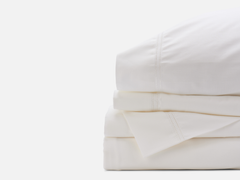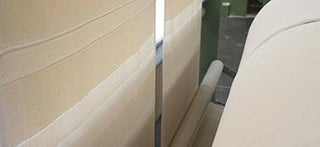Last week we traveled to 1888 Mills in Griffin, GA to see our first bath towels, The Leighton Collection, being made and document the process. The facility and the people there are truly remarkable! You can learn more about 1888 Mills itself here.
The Cotton
The cotton is from our 2016 crop and had already been spun into yarn by our spinning vendor in South Carolina. Unlike a lot of other towels that are woven from shorter fibers, we are still using our longest staple cotton to produce our bath towels. It's not necessary but we believe it's worth it.

Spinning The Yarn
The actual spinning of the yarn occurred just like it does for our bed sheets. You can read more in-depth about how our cotton is spun into yarn here. For our bath towels, however, there was one more step to take before our yarn was sent to the mill to be woven into the towels. We decided, in order to make the BEST and most LUXURIOUS bath towel we could, we would ply our yarn to produce a stronger and more absorbent towel. Just like our bedding, we want our towels to last, so this feature was very important to us.

So once our yarn was plied, it went straight to 1888 Mills to be made into our towels. Unlike our path to creating our sheets, everything is done under one roof at the mill. Which makes it a lot easier on us to put the puzzle pieces together! We are very thankful for this!


Warping
Once the yarn gets to the mill, it goes through the warping process. (also known as the most magical and maddening thing you will ever see). This occurs when we prep to make our bed sheets too. You can compare the flat woven process to the process by seeing our post about weaving our bed linen here.


Anyhow, warping consists of taking the large spools of spun cotton and winding it onto a large beam (aptly referred to as the warp beam) that will then be used in the weaving process. From there, these yarn goes through the sizing process. This is a process in which the yarn is stiffened so that it can better withstand the friction of weaving. The "sizing" is a combination of starch and wax that coats the fibers. The yarn is now ready for the loom!
Weaving (this is complicated)
Our towels are woven on dobby looms with two sets of warp beams. One warp is referred to as the "ground". Similar to the warp in our flat woven goods, this yarn will create the framework for our towel to exist upon. The second warp is for the "pile" or the "loops" that we know and love and makes a towel a towel. :)


Then comes the tedious task of feeding each thread through a metal eye and attaching it to its weaving "harness". You can see in the video, these harnesses raise and lower the warp threads so that the pile yarn can be passed between them.
Don't forget the weft! The weft (just like in the flat woven goods) shoots across the "ground" creating the "woven" fabric.

Our pile yarn is loosely threaded into the woven fabric and then when it is pressed into the fabric, the slack is pushed up and it becomes a little loop. (lots of trouble for a little loop... but that's how it's done). And of course, with the technology, we have today this all occurs in the blink of an eye.

Finishing
We were not able to photograph this part, as our towels were still in the weaving process, but here, the towel are bleached and all the sizing is removed. All towels must be bleached before there is any color added. The towel cloth is subject to very high heat (similar to that of South Alabama ;)) where the bleaching chemicals react with one another, resulting in a pure white towel. The towel cloth is then washed where all chemicals from the bleaching process are removed. At this stage in the game, our white towels will then go to be cut and sewn and packaged.
Our "natural" towel will go into a vat of dye to give it the creamy color we love in our natural bedding. This "cotton" color has to be added back in because a towel that has not been bleached has been shown to be less absorbent and not as luxurious feeling ;). The dye is pressed into the terry cloth by two large rollers that force the dye down into the towel.
The Design
The design of our towel was created specifically for Red Land Cotton by 1888 Mills textile engineers. It features chevrons and roping on the border which we feel adds an heirloom feel to these towels.


Many thanks to all of you who have pre-ordered! We hope you will love your 100% American Made and Alabama Grown cotton towels. I know we can't wait to get our hands on them and ship them to your door in our new boxes!


